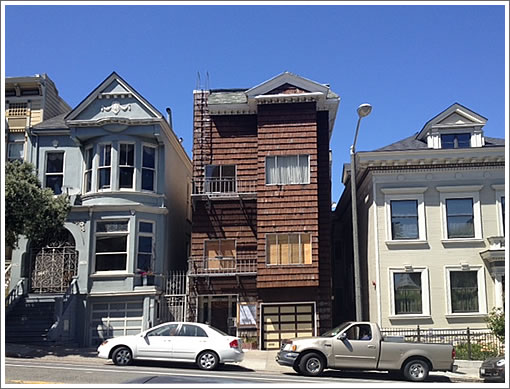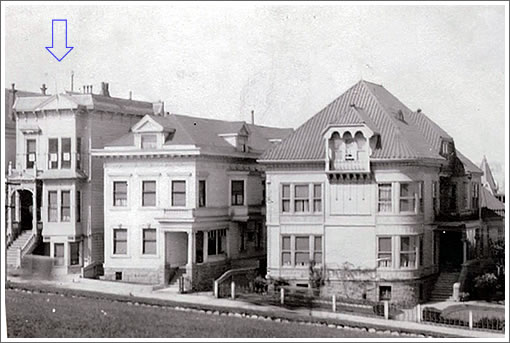
As we reported earlier this week, the buyer of the Alamo Square building at 1164 Fulton Street has proposed a restoration of the building’s façade, taking cues from surviving architectural elements and a historic photograph of Fulton Street in the 1920’s.

A plugged-in tipster has since delivered the aforementioned historic photograph.

And according to our tipster, while the garage at 1164 Fulton Street will remain, the plan is to bring back the grand stairs to the street as part of the restoration as well.
My third grade daughter has been studying San Francisco history with her class this year; they have all learned to identify Victorian architectural features like sunbursts, fish scale shingles, quoins, dentils, capital types, etc. Just this week, I accompanied them on a tour of the remarkable Haas-Lilienthal house (click my name link). Afterwards, my daughter was asking me why they stopped building Victorians. Styles changes, costs go up, and materials get harder to find, but it’s hard to imagine anyone ever thought the remuddled shingles, aluminum windows, tacked on fire escape/balconies, etc on this building were an improvement.
I live near this property and walk by it every day. Delighted to see it has been bought (finally) by someone with pockets deep enough to renovate it properly.
The property was being offered for sale in a somewhat hostile form of sale that required a judge to review and mitigate across multiple parties. It has been an eyesore among some of the nicest homes in SF for many years.
What a nice addition those two trees make to the cityscape. Although missing from the 1920s image, they make the street so much more inviting.
And who cares about restoring the ground floor, right? Not like any passers-by pay attention to that.
It looks awful right now, especially compared to the houses to the left and right. Here’s hoping that the Historic Preservation Commission works with the new owners and a respectful architect to get this place back to its former glory.
In the previous thread (link above), Dan wrote:
Emphasis mine.
This place, as well as 33 Valley Street in Noe (“Purchased as a vacant two-unit building…in 2010”) from Wednesday came to mind when I read Felix Salmon’s piece yesterday, Why America’s population density is falling. The relevant ‘graph:
Again, emphasis mine. The effect he describes is of course in no way specific to that area in the borough of Manhattan in New York City.
Some people like to say “they aren’t making more detached SFH’s in San Francisco”, but of course since dwelling unit mergers for high-end units aren’t controlled, the rich can always take a multi-unit building and get the low-density building or SFH they want by combining units and forcing up the price of property even further by reducing supply.
All the people advocating higher density as a way to enable more people to live in S.F. and perhaps slow the ascent of prices without government involvement? This is how your theory gets invalidated in practice, at least for the neighborhoods the rich want to live in.